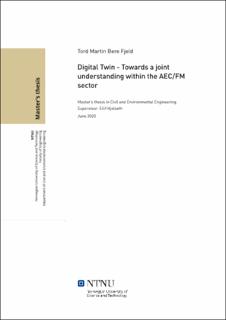Digital Twin - Towards a joint understanding within the AEC/FM sector
Master thesis
Permanent lenke
https://hdl.handle.net/11250/2779306Utgivelsesdato
2020Metadata
Vis full innførselSamlinger
Sammendrag
Digitale Tvillinger (DT) har kapasiteten til å transformere bygge-, anleggs- og eiendomsnæringen (BAE) og ta den inn i Industri 4.0. DT er sett på som en revolusjonerende måte å effektivisere informasjonsutveksling gjennom hele livsløpet til en digital modell og det bygget den imiterer. Det antas at DT vil tilføre verdi til hele BAE-næringen ved å effektivisere prosjektplanlegging og design, prosjekt gjennomføring og forvaltning. I dagens BAE-næring er DT kun et hypet begrep. Selv om begrepet har eksistert i nesten to tiår er det fortsatt ingen entydig forståelse av DT, og begrepet blir bredt brukt til å beskrive alt fra digitale modeller til cyber-fysiske systemer. Innen BAE-næringen blir DT ofte forvekslet med BIM. Der BIM er en utvidelse av en statisk 3D-modell med tilhørende informasjon, er DT et konsept som representerer en levende modell med data som flyter mellom en virtuell representasjon og et fysisk objekt. Målet med denne artikkelen er å undersøke hvilket modenhetsnivå forståelsen av DT ligger på i den norske BAE-næringen. Videre diskuterer artikkelen betydningen av begrepet, hvilke essensielle funksjoner en DT må ha og hvordan den kan generere verdi for næringen. Dette studiet foreslår også en Digital Tvilling Modenhets Indeks (DTMI), for å gi næringen en sårt trengt måte å uttrykke de ulike modenhetsstadiene til en DT og for å forbedre den felles forståelsen BAE-næringen har av konseptet DT. Digital twins (DT) have the capacity to transform the Architect, Engineering, Construction and Facility Management (AEC/FM) sector and take it into industry 4.0. DT is seen as a revolutionary way of managing an asset throughout its lifecycle, as it promises effective asset design, project execution and asset operation. However, within the AEC/FM sector today DT is just a buzzword. Despite the term existing for nearly two decades, there is still no unambiguously understood definition of DT and the term is broadly used to describe a variety of digital models and cyber-physical systems. Within the AEC/FM sector DT is often confused with BIM. Whereas BIM is an extension of a static 3D model including information, DT is a concept representing a living model with data flowing between the model representation and a physical entity. The aim of this extended paper is to investigate what level of maturity the understanding of DT is on within the Norwegian AEC/FM sector. It further elaborates on the meaning of the term, discussing essential features and how it can provide value for the sector. To provide a much-needed way of expressing the different maturity stages of a DT, this study proposes a Digital Twin Maturity Index (DTMI) to improve joint understanding of DT for the AEC/FM sector.
